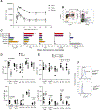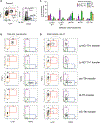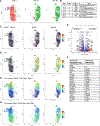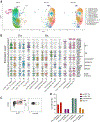A minority of Th1 and Tfh effector cells express survival genes shared by memory cell progeny that require IL-7 or TCR signaling to persist
- PMID: 39723889
- PMCID: PMC12009130
- DOI: 10.1016/j.celrep.2024.115111
A minority of Th1 and Tfh effector cells express survival genes shared by memory cell progeny that require IL-7 or TCR signaling to persist
Abstract
It is not clear how CD4+ memory T cells are formed from a much larger pool of earlier effector cells. We found that transient systemic bacterial infection rapidly generates several antigen-specific T helper (Th)1 and T follicular helper (Tfh) cell populations with different tissue residence behaviors. Although most cells of all varieties had transcriptomes indicative of cell stress and death at the peak of the response, some had already acquired a memory cell signature characterized by expression of genes involved in cell survival. Each Th1 and Tfh cell type was maintained long term by interleukin (IL)-7, except germinal center Tfh cells, which depended on a T cell antigen receptor (TCR) signal. The results indicate that acute infection induces rapid differentiation of Th1 and Tfh cells, a minority of which quickly adopt the gene expression profile of memory cells and survive by signals from the IL-7 receptor or TCR.
Keywords: CD4+ T cell; CP: Immunology; Tfh; Th1; immune memory.
Copyright © 2024 The Author(s). Published by Elsevier Inc. All rights reserved.
Conflict of interest statement
Declaration of interests The authors have no conflicts of interest.
Figures






References
-
- Homann D, Teyton L, and Oldstone MB (2001). Differential regulation of antiviral T-cell immunity results in stable CD8+ but declining CD4+ T-cell memory. Nat. Med. 7, 913–919. - PubMed
-
- Milner JJ, Toma C, He Z, Kurd NS, Nguyen QP, McDonald B, Quezada L, Widjaja CE, Witherden DA, Crowl JT, et al. (2020). Heterogenous populations of tissue-resident CD8+ T cells are generated in response to infection and malignancy. Immunity 52, 808–824.e7. 10.1016/j.immuni.2020.04.007. - DOI - PMC - PubMed
Publication types
MeSH terms
Substances
Associated data
- Actions
Grants and funding
LinkOut - more resources
Full Text Sources
Molecular Biology Databases
Research Materials
Miscellaneous

